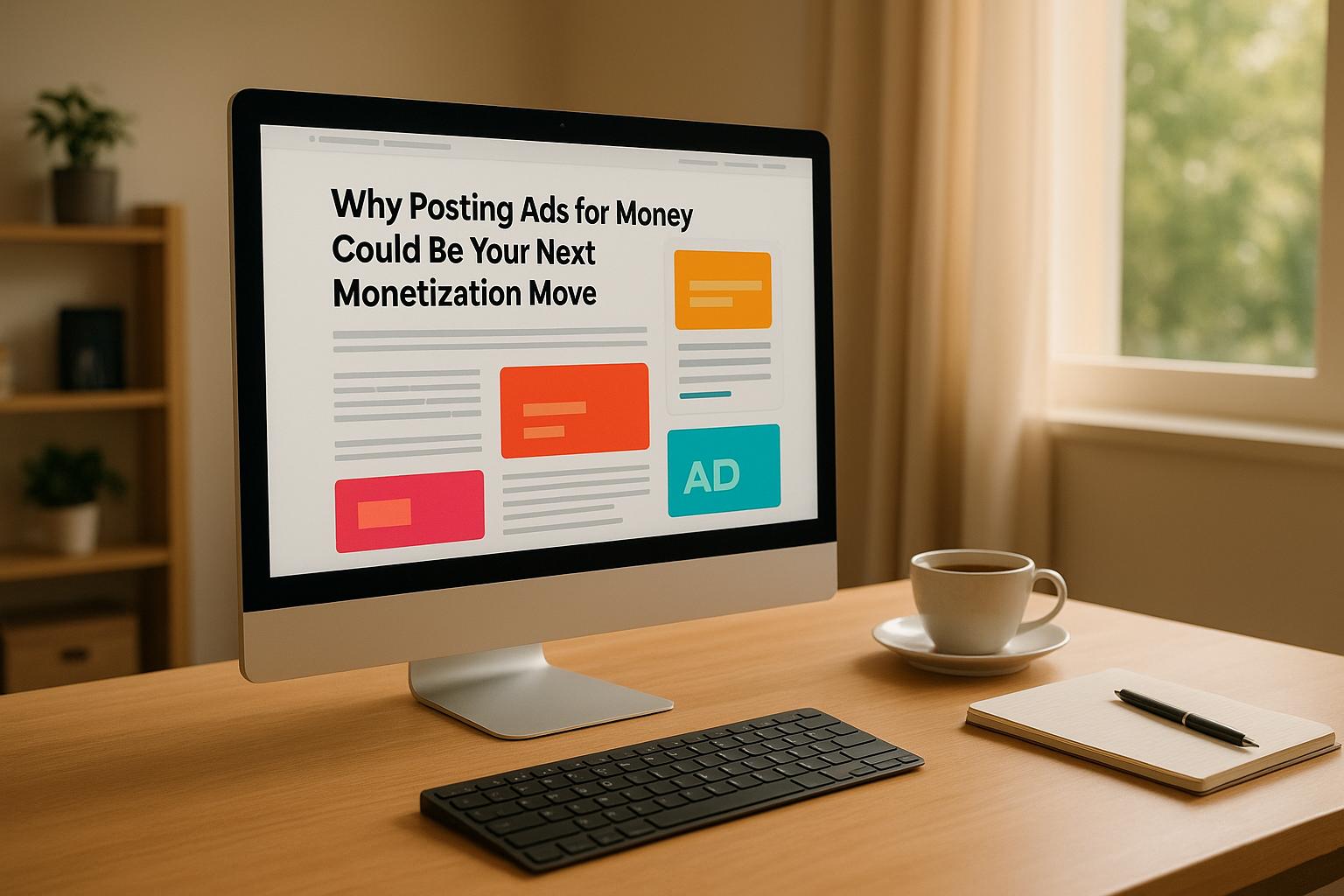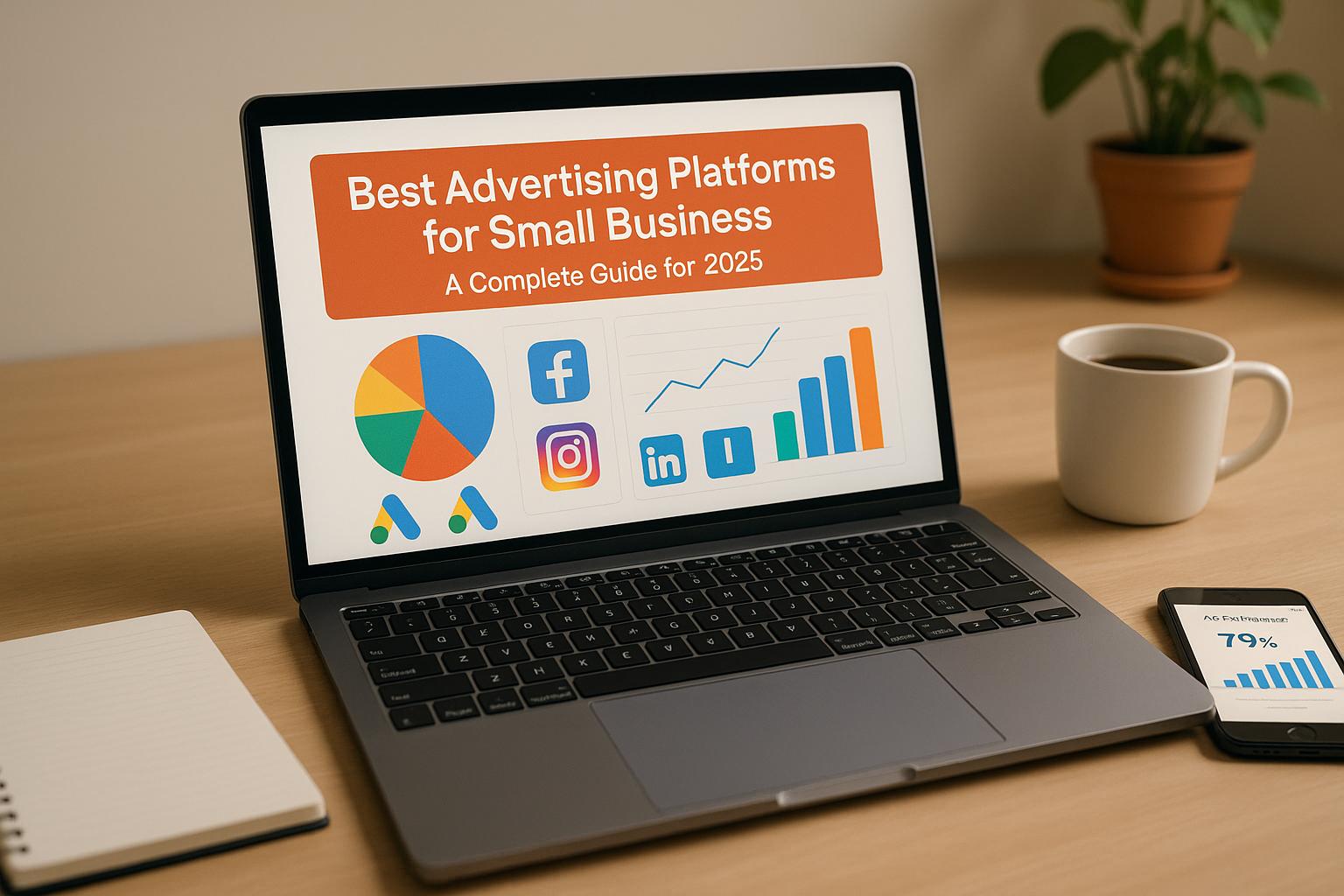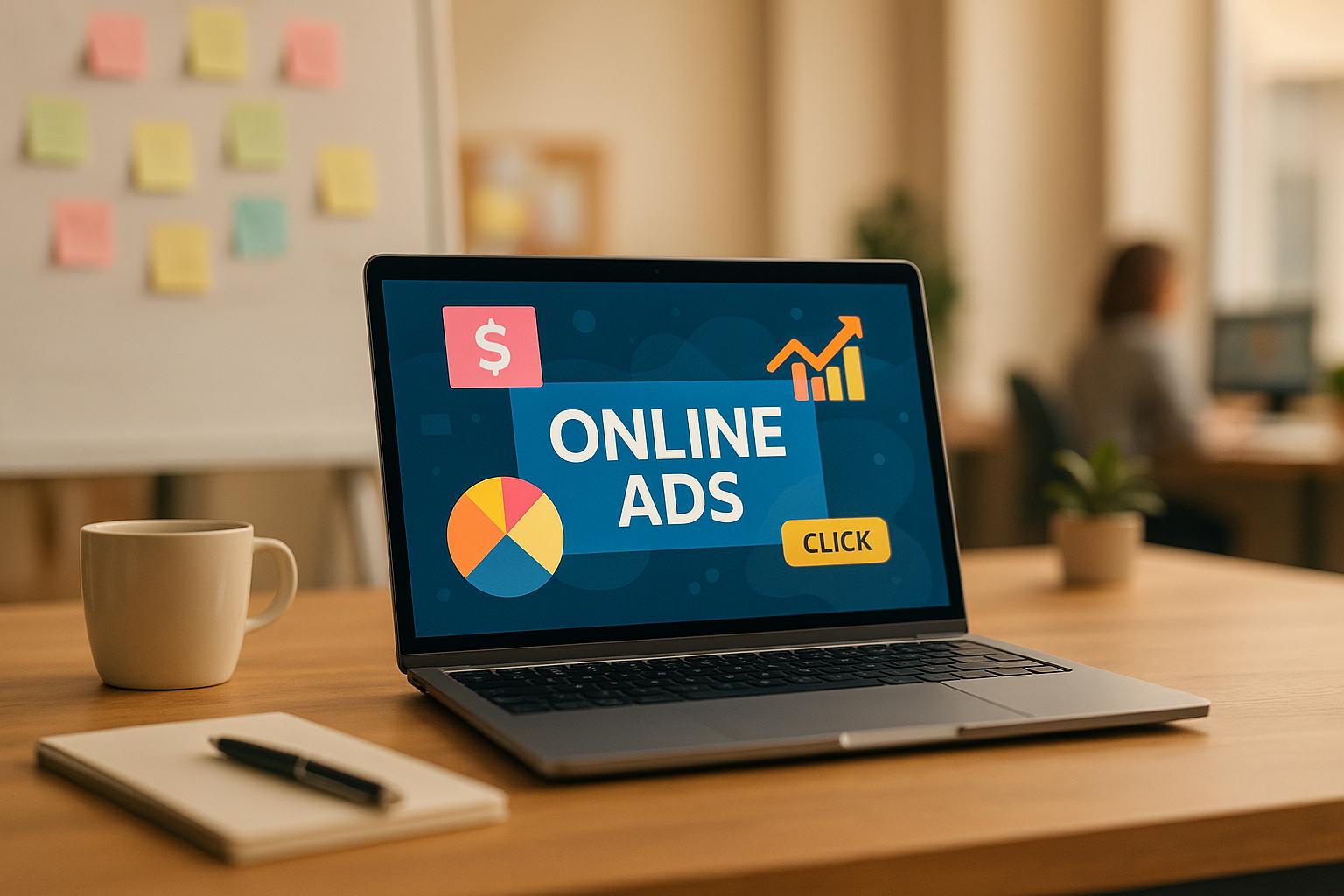Website ad revenue varies widely - from a few dollars to millions each month. Here’s what determines how much you can earn:
- Traffic Volume: Websites with 500,000 monthly visitors can earn $1,000–$5,000, while 1 million visitors can bring in $2,500–$25,000.
- Niche Matters: Topics like finance, health, and technology pay more. For example, finance blogs can earn up to $10 per 1,000 visitors.
- Ad Types: Native ads often perform better than traditional display ads, offering higher engagement and click-through rates.
- Traffic Quality: Visitors from Tier 1 countries (U.S., Canada, U.K., Australia) generate higher ad revenue.
- Ad Placement: Ads above the fold and in-content ads drive better results.
On average, U.S. publishers earn $4–$10 per 1,000 visitors, with finance and business niches leading in profitability. Tools like revenue calculators and strategies like header bidding can further boost earnings. Optimizing your site for mobile users is also key, as mobile ads now account for 65% of digital ad spend.
Quick Tip: Focus on high-quality content, choose a profitable niche, and experiment with ad placements to maximize revenue.
How Much Ad Revenue Can a Website Make?
What Affects How Much Ad Revenue You Make
Several key elements play a role in determining how much you can earn from ads on your website.
Your Website's Topic and Content Type
The niche your website focuses on has a direct impact on your ad revenue. Advertisers are willing to pay 35% more to advertise on niche sites because these platforms attract highly targeted audiences. This focus also leads to 53% higher engagement and 45% better affiliate conversion rates compared to broader, general-interest websites.
Certain niches, like business, finance, health, and technology, tend to be more lucrative. Why? Companies in these industries often have larger advertising budgets and are willing to pay premium rates to reach potential customers. For example, a financial advice blog can earn significantly more per ad click than an entertainment site because financial advertisers value qualified leads highly.
"The term [we use for] general marketing is 'a mile wide and an inch deep.' But for niche marketing, it's 'an inch wide and a mile deep.' This visual is a fair description of how niche marketing allows a business to tailor messaging in a way that breaks through surface-level communication." - Jimi Gibson, Vice President of Brand Communication, Thrive
Statistics back this up: 72% of successful bloggers credit their success to focusing on a specific niche, and brands that collaborate with niche websites see a 44% increase in engagement. By 2025, niche websites are projected to account for 40% of new online businesses.
But your niche isn’t the only factor - traffic quantity and quality also play a big role.
How Much Traffic You Get and Its Quality
When it comes to ad revenue, traffic is king - but not all traffic is created equal. While having a high number of visitors is important, the quality of that traffic is even more crucial. High-quality traffic comes from users who are genuinely interested in your content and more likely to interact with ads.
To earn meaningful income, most websites need between 10,000 and 50,000 monthly visitors, which typically translates to $1,000 to $5,000 per month. For instance, a niche site with 10,000 monthly visitors might earn $1,000 or more through affiliate marketing, while a general-interest blog with 50,000 visitors may only make $1,000 to $2,000 from display ads.
Traffic from Tier 1 countries - such as the US, Canada, the UK, and Australia - can significantly boost earnings. Advertisers often pay premium rates for these audiences, potentially doubling or tripling your revenue.
Organic traffic from search engines is especially valuable because these visitors are actively searching for information related to your content. In contrast, social media traffic tends to convert at lower rates since users are typically browsing casually rather than looking for specific solutions.
Metrics like time spent on your site and the number of pages viewed also influence your ad earnings. Bloggers who attract 1,000 to 5,000 visitors daily can earn approximately $100 per day.
Different Ad Types and What They Pay
The type of ads you use can make a big difference in your earnings. Native ads often outperform traditional display ads because they blend seamlessly with your content and tend to attract higher engagement.
Native ads are 53% more likely to be viewed than display ads and are 9 times more likely to be clicked. They also keep users engaged 18% longer, and 63% of consumers report a positive perception of brands that use native advertising.
Here’s a quick breakdown of how native and display ads compare:
| Ad Type | Click-Through Rate | Cost Per Click | Best Use Case |
|---|---|---|---|
| Native Ads | Higher (up to 0.3%) | More expensive | Building trust, mobile traffic |
| Display Ads | Lower (0.46% avg.) | Less expensive | Retargeting, desktop traffic |
In 2023, U.S. marketers spent over $97 billion on native ads, which have been shown to increase purchase intent by up to 18%. Native ads tend to perform better on mobile devices, while display ads are often more effective on desktops.
However, traditional display ads face challenges like "banner blindness", where 86% of users ignore banner ads, and 40% actively avoid intrusive ads. This has made native advertising an increasingly attractive option.
Ad networks like TinyAdz help publishers connect with high-value campaigns by focusing on real human impressions and hyper-targeted advertising. This approach not only improves engagement rates but also increases revenue per visitor by aligning ads with user interests and behaviors.
How Much U.S. Publishers Actually Earn
Let’s take a closer look at how much publishers in the U.S. actually make. Earnings can vary a lot depending on factors like website size, niche, and how effectively ads are optimized.
Monthly Earnings by Website Size
For smaller sites, monthly earnings generally hover around $1,000. This serves as a starting point for those looking to grow.
Medium-sized websites bring in more substantial income. For instance, a business site with 50,000 page views per month typically earns about $917 monthly, while a news site with the same traffic might only generate $167 per month.
Larger websites with significant traffic can see impressive returns. A business site attracting one million monthly visitors can rake in over $220,000 annually, which breaks down to roughly $18,000 monthly. On the other hand, a news site at the same scale might earn around $43,000 per year, or about $3,583 monthly.
Premium ad networks offer rates of $5–$50 per thousand page views. To put that into perspective, a site with 50,000 monthly page views could earn anywhere from $3,000 to $30,000 annually.
Earnings by Website Topic
The niche your website focuses on plays a huge role in determining ad revenue. Here’s a breakdown of estimated earnings per 1,000 visitors across various topics:
| Niche | Revenue per 1,000 Visitors |
|---|---|
| Business & Finance | $10.02 |
| Travel | $10.02 |
| Weddings | $10.02 |
| Health & Fitness | $6.80 |
| Home & Architecture | $6.80 |
| Government & Politics | $6.80 |
| Pets | $6.12 |
| Beauty & Fashion | $6.12 |
| Sports | $5.44 |
| Automotive | $5.44 |
| Food and Drink | $4.76 |
| Gaming | $4.76 |
| Education | $4.76 |
| Technology | $4.08 |
| Cryptocurrency | $3.40 |
Finance websites tend to lead the pack, with RPMs ranging from $30 to $50. This explains why business and finance niches often outshine others in terms of ad revenue.
The ad market continues to expand, with U.S. advertising sales projected to hit $380 billion in 2024, marking a 12.4% increase. Digital Pure Players - businesses operating solely online - are expected to see their ad revenues grow by 9.6%, reaching $293 billion.
What You Can Expect to Earn
When setting expectations, consider these benchmarks: U.S. publishers can anticipate CPCs of $0.45–$0.61, RPMs of $4.59–$6.15, and CPMs near $0.68 .
Digital ad spending in the U.S. is forecasted to reach $455.9 billion by 2025, with digital ads expected to account for 80% of total ad spending by 2029. This growth opens up more opportunities for publishers.
Additionally, mobile advertising now makes up 65% of total digital ad spend in the U.S., emphasizing the importance of optimizing websites for mobile users.
sbb-itb-957fd63
Tools and Methods to Make More Ad Money
Boosting your ad revenue isn’t just about slapping ads on your site - it’s about using the right tools and strategies to maximize every opportunity. A smart, data-backed approach can make all the difference.
Tools to Calculate Your Potential Earnings
If you’re wondering how much your site could earn, revenue calculators are a great place to start. For example, Snigel's AdSense revenue calculator uses Google data to estimate earnings based on your region, website category, and monthly page views. Plus, incorporating header bidding could increase your revenue by 35%-65%.
Another option is Mailmodo's ad revenue calculator, which digs a little deeper. It factors in monthly visitors, page views per visitor, the number of ads per page, and your average CPM.
For those exploring programmatic advertising, MonetizeMore’s calculator considers RPM, pageviews, ad units per page, and even traffic quality by geographic tier. Similarly, EthicalAds’ tool focuses on monthly page views and estimated CPM to provide an idea of potential earnings.
Of course, these tools can only give you estimates. Your actual revenue depends on factors like your audience demographics, content niche, seasonal trends, and how users interact with your site. For a more accurate picture, The Website Flip suggests researching typical RPM rates in your industry.
Here’s a fun fact: 79% of the top 1,000 U.S. websites use header bidding to supercharge their earnings. Once you’ve calculated your potential revenue, the next step is to optimize your ad placements.
Where to Place Ads for Best Results
Ad placement isn’t just about cramming ads wherever there’s space - it’s about strategy. In fact, 49% of publishers say optimizing ad placements is their top revenue-boosting tactic.
Above-the-fold ads - those visible without scrolling - are a no-brainer. Google studies show they achieve 73% viewability compared to 45% for below-the-fold placements. But don’t overdo it. Too many ads in this area can slow your site down and irritate users.
In-content ads are another winning strategy. Placing ads between paragraphs, around images, or using sticky ads that stay visible as users scroll can drive engagement. To find the sweet spot, use A/B testing to experiment with placements and track which ones perform best. Heatmaps can also help identify high-traffic areas on your pages where ads are most likely to grab attention.
Don’t overlook native advertising, which blends seamlessly with your content. These ads often outperform traditional banners because they feel less intrusive.
"The more your ad is relevant and visible, the chances of users viewing and clicking on the ad - increases. So, place the banner ad to the right users (audience targeting) at the right placement (where your user engagement tends to be higher)." - Solutions, Mile.tech
Once you’ve nailed your placements, it’s time to think beyond banners.
Making Money Beyond Banner Ads
If you’re relying solely on banner ads, you’re leaving money on the table. Diversifying your ad revenue streams not only boosts earnings but also protects you from market swings. According to Digiday, 58% of publishers expect advertising to make up more than 40% of their revenue in the next year.
TinyAdz offers several ways to expand your revenue streams:
- Newsletter monetization: Add targeted ads to your email campaigns to reach engaged subscribers.
- Social media monetization: Generate income by leveraging your presence across platforms.
- Event sponsorships: Host webinars, conferences, or virtual meetups and sell premium ad space to brands.
- Directory monetization: Allow businesses to list their services on your site for a steady stream of passive income.
Another promising avenue is video advertising and Connected TV (CTV). With streaming on the rise, this space is expected to drive significant revenue growth. Podcasts are also gaining traction, with ad spending projected to grow by 39% in 2024.
Finally, consider programmatic advertising. With advertisers expected to spend over $200 billion in programmatic ads by 2026, this automated approach can help you fill inventory gaps and maximize earnings from every page view.
The bottom line? The more you diversify and optimize, the more opportunities you create to grow your ad revenue. Tools, placements, and new formats all play a part in building a sustainable income stream.
Main Points for U.S. Publishers
Earning revenue from website ads isn’t just about slapping banners on a page - it’s about understanding your audience, setting achievable goals, and using the right tools to make the most of your efforts. These principles are at the heart of any successful digital monetization strategy.
Your choice of niche plays a huge role in determining your earning potential. For instance, high-demand niches like insurance, legal, and finance can command impressive CPCs - $55.20, $45.50, and $30.10, respectively. In contrast, general entertainment sites typically see much lower rates. Similarly, finance and insurance websites often enjoy CPM rates ranging from $15 to $50 or more, while general news or entertainment sites usually fall in the $0.50 to $3 range.
When setting benchmarks, aim for an eCPM of $5–$10 and a conversion rate between 1–3%. Keep in mind factors like seasonality, audience engagement, and your niche’s unique characteristics when forecasting your earnings. Beyond these benchmarks, your choice of monetization platform can have a significant impact on your bottom line.
Programmatic platforms, for example, can increase ad earnings by as much as 57%. With projections showing that 81% of digital ad revenue will come from programmatic platforms by 2028, choosing the right platform is critical to staying competitive. TinyAdz, for instance, offers a variety of monetization options, including directory listings, social media, newsletters, and event monetization - all without requiring a minimum level of traffic.
The broader advertising landscape is also promising. Global ad spending is expected to hit $1.07 trillion in 2024, while U.S. internet ad revenue is projected to reach $225 billion in 2023, marking a 7.3% year-over-year increase. Video advertising, in particular, is on the rise, with worldwide spending forecasted to grow by 8.3% in 2024.
Achieving sustainable ad revenue requires a thoughtful approach. Start by creating high-quality content that resonates with your audience and strategically place ads based on performance data. Avoid overwhelming your pages with too many ads, as this can drive visitors away. Diversifying your income streams - whether through programmatic ads, sponsored content, or other revenue channels - can also help protect against market fluctuations and maximize your earnings.
The ultimate goal is to balance ambitious revenue targets with a positive user experience. Overloading your site with ads can alienate visitors, while too few ads may leave money on the table. Regularly test and refine your strategies to align with your audience’s preferences. By combining targeted ad placements, diversified revenue streams, and a user-first mindset, U.S. publishers can unlock their full earning potential.
FAQs
How do I choose the best niche for my website to maximize ad revenue?
To boost your ad revenue, it's smart to focus on niches where advertisers are willing to pay a premium. Categories like insurance, real estate, health and fitness, and digital marketing often command higher CPMs (cost per thousand impressions) because of their competitive markets and the value they offer to advertisers.
But it's not just about the niche; your audience plays a huge role too. Niches that attract highly engaged, targeted, and valuable audiences tend to perform better in terms of CPC (cost per click) and RPM (revenue per thousand impressions). Choose topics that match your expertise and can consistently bring in quality traffic. This way, you’re setting yourself up for steady and sustainable earnings.
How can I attract high-quality traffic to my website to boost ad revenue?
To bring in high-quality traffic and boost your ad revenue, the key is crafting content that truly resonates with your audience. When your content is engaging and provides real value, it naturally attracts visitors who are more likely to interact with your site - and your ads.
Make sure your website is optimized for search engines by focusing on high-value keywords and improving your overall SEO. Building trustworthy backlinks from respected sources can also strengthen your site's authority and improve visibility. At the same time, keep your ads relevant and unobtrusive - ads that blend seamlessly with the user experience tend to perform much better.
Use analytics tools to dive into your audience's behavior and preferences. Understanding what your visitors want allows you to fine-tune your strategies and attract traffic that aligns with your goals. This approach not only enhances user satisfaction but also helps you get the most out of your ad placements.
What makes native ads more effective than traditional display ads for monetizing websites?
Native ads work so well because they blend effortlessly with your website's content, offering a smoother user experience and encouraging stronger engagement. Unlike traditional display ads, which can sometimes interrupt the browsing experience, native ads align with your site's design and tone, making them feel like a natural part of the page.
This seamless integration helps build trust with your visitors, often resulting in higher click-through rates and improved overall performance. On top of that, native ads tend to be more tailored to your audience, making them more relevant and valuable. This relevance can play a big role in increasing your site's earning potential.


